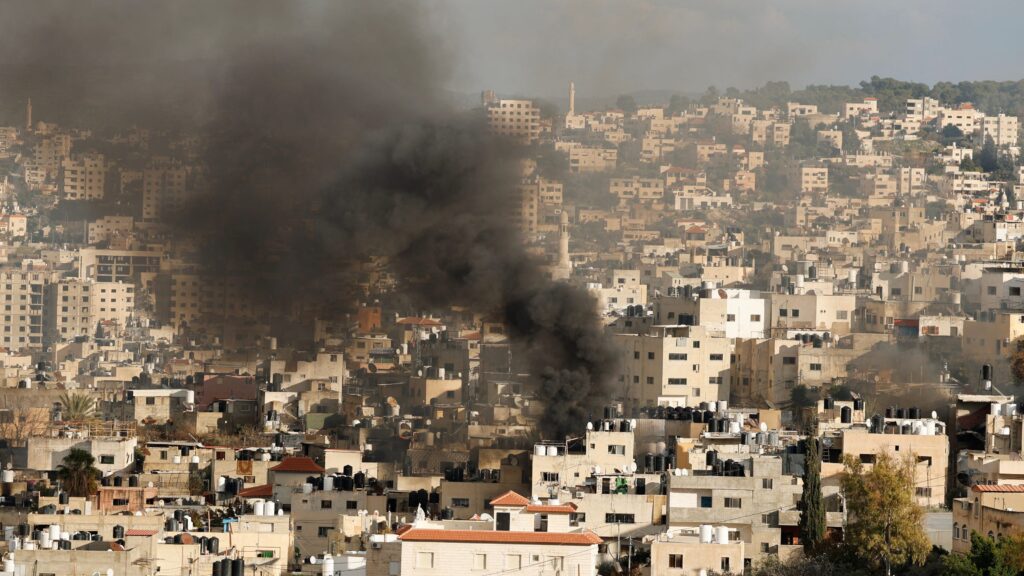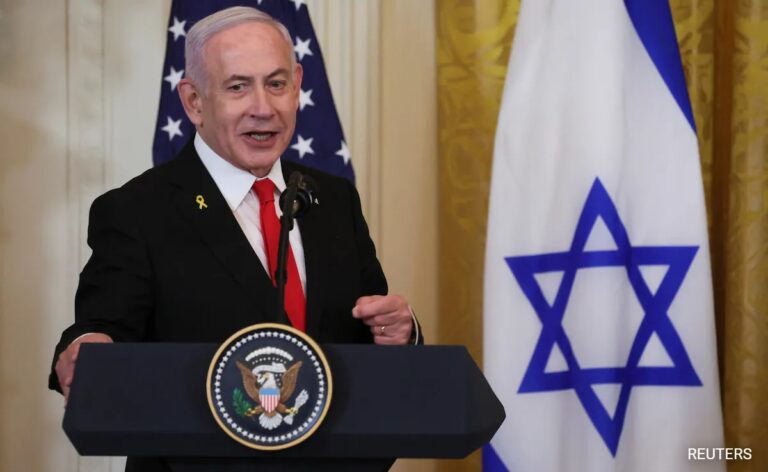
The ceasefire and hostage release deal secured between Israel and Hamas last month stirred hopes that, after 15 months, the bloodshed in Gaza was over − and that the hostages will finally return home.
But this week, violence flared once again in the West Bank as Israel’s military detonated buildings in the Jenin refugee camp on Tuesday and a gunman opened fire on Israeli troops, setting off a gunfight that killed at least two soldiers.
And Israel’s airstrikes on the territory continued weeks after it launched what Prime Minister Benjamin Netanyahu called “large-scale and significant” raids on Jenin hours after President Donald Trump, who has already weakened punitive sanctions on Israeli settler violence, was sworn into office.
Israel’s military exploded around 20 buildings in Jenin, including a local hospital, according to Reuters, citing the Palestinian news agency WAFA. Clouds of smoke billowed into the air as Israel continued what it called a military operation targeting militants and seizing stockpiles of weapons.
Meanwhile, two Israeli soldiers died and eight were injured when a gunman opened fire on troops at a checkpoint in Tayasir, in the northern West Bank. Wielding an M-16 rifle, the attacker set off a gunfight that lasted several minutes, Israeli news outlet Ynet reported.
Israel’s raids, launched on Jan. 21, coincided with Trump taking office. Already, the President has stood down the past administration’s condemnations of Israel’s West Bank settlements – declared illegal by international authorities. And he has stocked his cabinet with appointees who believe Israel has a biblical right to take over the West Bank.
Dig deeper:Donald Trump nominates Mike Huckabee to be US ambassador to Israel
At least 25 Palestinians have been killed since the raids began, including a two-year-old girl shot dead on Jan. 25 in Ash-Shuhada, a village just south of Jenin.
Gunfire came through the house’s windows “without any warning,” Ghada Asous, the girl’s grandmother, told Reuters. Israel’s defense forces claimed suspected militants were barricaded in the house and said it was reviewing reports of civilian injuries.
It reported at least 10 additional people killed in the raids in total, and 100 wanted individuals arrested.
On a visit to the refugee camp last week, Israeli Defense Minister Israel Katz said the siege would continue until Israel’s goals, which he did not specify, were completed.
“The Jenin refugee camp will not be what it was,” he said. “After the operation is completed, IDF forces will remain in the camp to ensure that terrorism does not return.”
Netanyahu sees path to annex West Bank with Trump in office
Netanyahu, his allies, and supporters of West Bank settlement expansion indicated they were looking with hope towards Trump taking office.
Related:Trump floats plan to ‘just clean out’ Gaza, move Palestinians to Egypt and Jordan
Just a week into his presidency, the Trump administration already has removed sanctions on settlers and appears likely to stand by as Israel increases its crackdown on the West Bank.
Israel unleashed its raid hours after Trump signed an executive order revoking sanctions imposed by former President Biden on dozens of Israeli settlers and groups who have attacked Palestinian civilians in the West Bank. Trump signed the order just hours after beginning his second term.
Trump’s cabinet is on the same page. At her confirmation hearing last Tuesday, Elise Stefanik, Trump’s pick for U.S. ambassador to the U.N., said she concurred with the view of Israeli Finance Minister Bezalel Smotrich and other extreme right-wing Israel leaders that Israel has a “biblical right” to seize the West Bank.
Pete Hegseth, Trump’s newly sworn-in secretary of Defense, has expressed support for annexing the West Bank and “applying Israeli sovereignty to Judea and Samaria,” he said, using the biblical names for the territory. Mike Huckabee, Trump’s yet-to-be-confirmed ambassador to Israel, has rejected any name for the area other than “Judea and Samaria,” saying Israel “has title deed” to the area.
West Bank violence ramps up alongside Gaza war
Hamas’ deadly Oct. 7, 2023, attack on Israel, which killed 1,200 Israelis and resulted in hundreds being taken hostage, not only led to Israel launching its siege of Gaza, but it also marked the start of an escalation of violence in the Palestinian West Bank.
More:‘Self-silencing’: For Palestinians, talking about Hamas comes with hazards
With attention turned towards war-torn Gaza, Israeli settlers in the territory took an opportunity to expand into the territory. The International Crisis Group logged 1,000 instances of settler violence and more than 1,300 Palestinians displaced from the Oct. 7 attack through last September, a significant spike.
As violent clashes increased, Israel launched successive raids on the territory, saying it was targeting Palestinian militants and terrorist cells. Dozens were killed, including a 26-year-old American-Turkish dual citizen participating in a protest against Israeli occupation. Then-U.S. Secretary of State Antony Blinken called the shooting “unprovoked and unjustified,” while Turkey branded it a “murder carried out by the Netanyahu government.”
Israel kills pair of militants who shot 3 Israelis
Israel said it launched the raids in response to the fatal shooting of three Israelis early last month by two Palestinian gunmen affiliated with the militant group Palestinian Islamic Jihad.
Two women residents of a settler community and one man from northern Israel who worked as a police investigator were killed on Jan. 6 in the village of al-Funduq by two Palestinians affiliated with the militant group.
Israeli forces announced Thursday that they had killed the perpetrators – Mohammed Nazzal and Qutaiba Shalabi, 25 and 30, respectively.
Military raid comes after Israeli settler attacks
Smotrich said the military operation was launched “for the protection of settlements and settlers” and that it would be “strong and ongoing.”
In the lead-up to the raids, bands of Israeli ultranationalist settlers had rampaged through the area, destroying property, setting fire to buildings and demolishing barricades set up by the Palestinian Authority, which governs the West Bank.
More:Trump floats plan to ‘just clean out’ Gaza, move Palestinians to Egypt and Jordan
More than 200 settlers took part in the attacks, Abdulmalek Farajallah, a resident of the village, told Reuters. “There was a carpenter’s shop here where I have been working for the past eight years,” he said. “They burned it down, and our neighbors’ buildings and cars over there. No one can do anything.”
Now, Jenin residents are fleeing their homes by the hundreds. Last week, orders to leave blared out loud from drones hovering over the city, Reuters reported. People lugged their belongings in suitcases and plastic bags as they evacuated on foot – bulldozers had dug up roads throughout the area, making car travel difficult.
Israel’s military denies it told people to leave their homes, saying it would allow “any resident who chooses to exit from the area to do so via secure and organized routes with the protection of Israeli security forces.”
When did Israel take control of West Bank and Gaza?
Israel first took control of the West Bank, Gaza and East Jerusalem, the region’s three Palestinian territories, in the 1967 Six-Day War. Since then, around 465,400 Israelis have moved into West Bank settlements, the majority of which international law deems illegal.
Netanyahu’s far-right coalition in Israeli politics has named expansion of West Bank settlements a top priority.


